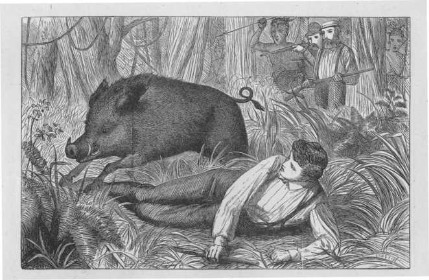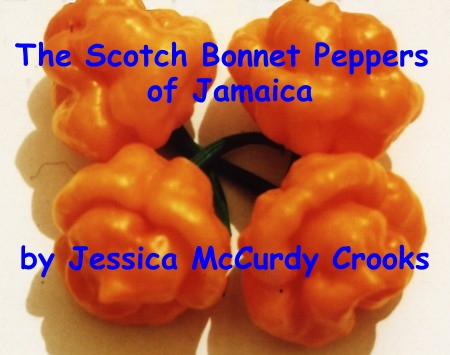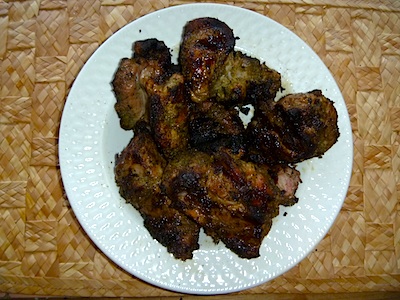Edited by Dave DeWitt
Editor’s Note: Mostly using the incredible resource of Google Books, I’ve compiled a chronological history of jerk pork from primary sources. Also, in early Jamaica, a “barbecue” was also a flat surface, usually made of stone or paved, where coffee beans, ginger root, and pimento berries were air-dried.
“Jamaican pigs were far better tasting, more nourishing, and much easier to be digested, than those of Europe; which is the reason why it is so much eaten in this, and indeed all the other islands throughout the West Indies.” –Richard Blome, A Description of the Island of Jamaica, London: J. Williams, Jr., 1672.
[Wild hogs were] “cut open, the bones taken out, and the flesh is gash’d on the inside into the skin, fill’d with salt and expos’d to the sun, which is call’d jirking… [This meat was] brought home to their masters by the hunters, and eats much as bacon, if broil’d on coals.” –Hans Sloane, A voyage to the islands Madera, Barbados, Nieves, S. Christophers and Jamaica: with the natural history of the last of those islands. London: BM, 1707.
“The fame of our Jamaican barbecue and brawn is so well established, that it would serve no purpose to reiterate their praises, except to tantalize the reader. The tame sorts are a very profitable stock to the settler or planter, as they multiply fast, and are kept or fattened with very little trouble. One boar is generally allowed to ten sows.” –Edward Long, The History of Jamaica. London: T. Lowndes, 1774.
[The use of the term “jerk” for pork barbecue appeared as early as 1778.] “The hunters shoot the beeves for their hides, as they do in Cuba; and, with regard to the pork, they strip the flesh from the hones, and jerk it as they do in Jamaica.” —The North-American and the West-Indian Gazetteer, London: G. Robinson, 1778.
[According to William Beckford, author of the gothic novel, Vathek] “Those wild boars that I have seen brought in by the negroes, or the parts of which I have occasionally received as presents, do not in, colour or in size, resemble those in Europe: they rather appear to be the progeny of swine that have strayed into the woods; and which, from having been once tame, partake of the habits of, and now become, wild, but are not, rigidly speaking, of the same species. I have seen them in a young state; but I did not perceive that they were marked by those stripes and colours which are observable in the wild pigs of other countries: and if there be really wild hogs in Jamaica, and such as are found in Germany and in other European countries, I can only say that I have not ever seen them…. The negroes smoak and dry this animal, from when the pieces thus smoaked, obtain the appellation of jirked hog; and it is, when thus cured, a very savoury and a pleasing relish.”–William Beckford, A Descriptive Account of the Island of Jamaica. London: T. an J. Egerton, 1790.
“The wild hog is still to be found in great numbers in the remote woods, where they are occasionally hunted. Hunting the wild boar was a favourite diversion here, both to the hardy active Creole whites of the interior, and to the Maroons. It is not now so often practised, these animals having retired far back into the woods; so that when their flesh is desired for a barbecue (considered as a great delicacy here, being the hog’s flesh smoked with a certain odoriferous wood, which communicates to it a peculiar flavour), negroes are usually sent in quest of them. The wild boar is hunted with dogs, who keep him at bay while the huntsmen take aim at him with their guns ; the dogs durst not approach him, he is so fierce and terrible in his attacks; with his monstrous tusks he would soon annihilate them, did they venture to encounter him too closely. It is supposed that the wild hog of Jamaica is not an original native of the island, but a descendant from those which the first discoverers and others may have left there. –John Stewart, An Account of Jamaica, and Its Inhabitants. London: Longman, Hurst, Rees, and Orme, 1808, p. 78.
[The following excerpt is from the 1816 journal of Matthew Lewis, author of The Monk, who died at sea, on the voyage homewards from the West Indies, in the year 1818.]
“Several gentlemen of the county dined with me to-day. We had at dinner a land-tortoise and a barbecued pig, two of the best and richest dishes that I ever tasted, the latter, in particular; it was dressed in the true maroon fashion, being placed on a barbecue (a frame of wicker-work, through whose interstices the steam can ascend), filled with peppers and spices of the highest flavour, wrapped in plantain leaves, and then buried in a hole filled with hot stones, by whose vapour it is baked, no particle of the juice being thus suffered to evaporate. I have eaten several other good Jamaica dishes, but none so excellent as this, a large portion of which was transferred to the most infirm patients in the hospital. Perhaps an English physician would have felt every hair of his wig bristle upon his head with astonishment at hearing me this morning ask a woman in a fever, how her bark and her barbecued pig had agreed with her. But with negroes, I find that feeding the sick-upon stewed fish and pork, highly seasoned, produces the very best effects possible.” –Matthew Lewis, A Residence Among the Negroes in the West Indies. London: John Mukray, 1861.
“Barbecue is, I find, a term used in the West Indies for dressing a hog whole, by splitting it to the backbone and laying it upon a large gridiron, raised about two feet above a charcoal fire, with which it is also surrounded. This may be described as “going the whole hog.” Hence it may have come to be applied to anything spread out to be dried or cured by the action of heat. I cannot discover the derivation of the word, but the process may be derived from the Maroons, who were ardent hunters of wild boars; and it was probably a primitive manner of dressing pork al fresco ; it appears, moreover, to have been a successful one, for “Monk” Lewis, who was a gourmet, and of whom Byron wrote,
I would give many a sugar-cane
Monk Lewis were alive again!
In his Journal (January 14, 1816), he includes it among the delicacies of Jamaica fare: “Land and sea turtle, quails, snipes, plovers, pigeons, and doves; excellent pork, barbecued pigs, pepperpots, with numberless other excellent dishes, form the ordinary fare; and even the Lord Mayor need not blush to give his aldermen such a dinner as is placed on my table, even when I dine alone.”
Pope, in Satire II., addressed to Mr. Bethel, writes:
Oldfield, with more than harpy throat endued,
Cries, “Send me, gods ! a whole hog barbecued!”
I now recollect that delightful Tom Ingoldsby uses the expression in “A Lay of St. Gengulphus,” and I never understood till now what it meant:—
Now the festive board with viands is stored,
Savoury dishes be there, I ween;
Rich puddings and big, a barbecued pig,
And ox-tail soup in a china tureen.
–Sir James Sibbald and David Scott, To Jamaica and Back. London: Chapman and Hall, 1876, p. 105.
The [maroon’s] most stirring pastime was the hunting of the wild hog. This pursuit served the purpose of chevies for negro runaways, till trafficking in jerked pork and in rewards for apprehended runaways became a systematised business with them. In the days of slavery, the Maroon huntsman was a fine specimen of the athletic negro, on whom was stamped the impress of the Freeman. He was generally seen in the towns armed with a fowling piece and cutlass, and belts that suspended on one side a large plaited bag, known as a cuttacoo, and on the other a calabash, guarded with a netted covering, in which he carried his supply of water. On his back, braced round his shoulders, and suspended by a bandage over the forehead, was generally seen the wicker cradle, that held inclosed a side of jerked hog, which he sold passing along, in measured slices, to ready customers, as an especial delicacy for the breakfast table. The accoutred Maroon, with this vendible commodity, was altogether a striking and characteristic figure in our streets. The abolition of slavery having absorbed him in the general mass of liberated negroes, he has abandoned the huntsman’s life for that of the husbandman. The pursuit of wild hogs has terminated with the rewards for runaway slaves; and in this age of railways and steam navigation, the flitches of American bacon in the provision shops have driven out of the market the jerked hog of the Maroon. –Philip Henry Gosse. A Naturalist’s Sojourn in Jamaica. London: Longmans, Brown, Green and Longmans, 1851.
“On arriving at our Barracks at 3:30 the men set to work at once to prepare for ‘jerking’ the pigs. Outside the hut they constructed a gridiron of green sticks about two feet from the ground. This is called about the Blue Mountain Valley a ‘patta,’ while among the Maroons, and in the Cuna-Cuna district it is known as a ‘caban’—a word that has a distinctly Spanish flavour. Underneath this a fire is kindled, into which the carcase is first thrust in order to singe the hair, which is then easily scraped off with a knife. This done, the animal is disembowelled, split open down the back, the bones extracted, and the carcase laid skin downwards upon the sticks and subjected to a slow grilling during which it is plentifully sprinkled with black pepper and salt. This process lasts from six to eight or nine hours, according to the size of the animal. The adding of pimento leaves, or those of the pepper elder to the fire imparts an improved flavour to the meat, which, when properly done, is as gamey and toothsome a dish as a hungry man can desire. We had wild pig chops, fresh, for dinner that night, and jerked the greater portion of the two animals for next day, the dogs receiving their reward in the shape of the offal.” –Herbert T. Thomas, Inspector, Jamaica Constabulary, Untrodden Jamaica. Kingston: A. W. Gardner, 1890.
“Wherever the hog is killed there the camp is pitched—water is always near by in these wonderful mountains—and, a fire being kindled, the process of “jerking” is begun. That is a slow grilling over a wood fire, among the embers of which aromatic leaves are cast, while powdered pimento seed and salt are sprinkled upon the meat. The dogs are amply rewarded by the offal, and soon curl themselves, gorged, as near the fire as they can creep, to enjoy a well earned rest. Night comes down, the strong land-breeze rushes seaward from the Peaks singing a mournful dirge among the treetops; the fitful glare of the fire throws weird shadows among the tall trees, eclipsing the twinkle of the firefly that flits among the leaves; and all is silence and slumber, save when a gaunt figure steals out of the hut, its lean proportions doubly grotesque in the uncertain firelight, to watch the progress of the grilling of the prized meat. If their luck is good they may take three or four hogs in a couple of days, as much as they can carry home; and the meat prepared as above described is readily disposed of at ninepence and sometimes a shilling a pound ; for when properly done it is a most toothsome morsel, and perfectly clean and wholesome, as the food of these wild hogs consists entirely of roots, berries and fruit, and their drink of the purest water. Any more health-giving amusement than a few days of hog hunting among the Blue Mountain forests it is almost impossible to conceive; but, as already intimated, one must be in first-rate condition.” –Lt. Col. Charles J. Ward, Honorary Commissioner for Jamaica, Jamaica at Chicago: An Account Descriptive of the Colony of Jamaica, with Historical and Other Appendices. New York: William J. Pell, 1893.
“Barbecue is, I find, a term used in the West Indies for dressing a hog whole, by splitting it to the backbone and laying it upon a large gridiron, raised about two feet above a charcoal fire, with which it is also surrounded. This may be described as “going the whole hog.” Hence it may have come to be applied to anything spread out to be dried or cured by the action of heat. I cannot discover the derivation of the word, but the process may be derived from the Maroons, who were ardent hunters of wild boars; and it was probably a primitive manner of dressing pork al fresco; it appears, moreover, to have been a successful one.” –Sir James Sibbald David Scott, To Jamaica and Back. London: Chapman and Hall, 1876.
“The technique of jerking was originated by the Maroons, Jamaican slaves who escaped from the British during the invasion of 1655 and hid in the maze of jungles and limestone sinkholes known as the Cockpit Country. The Maroons seasoned the pork and cooked it until it was dry and would preserve well in the humdity of the tropics. During the twentieth century, the technique gained enormous popularity in Jamaica and today “jerk pork shacks” are commonly found all over Jamaica. The method has evolved, however, and the pork is no longer overcooked.” Dave DeWitt, Hot & Spicy Caribbean, 1996.
Editor’s Note: The first recipe I could find for any jerked meat was not even barbecue, but Caribbean Jerk Pork Roast that was published in Recipes from Around the World published by BestHowToBooks in 1922. I could not find an author or any information on the publisher.
Note: Related Article, Authentic Jamaican Jerk, is here.









